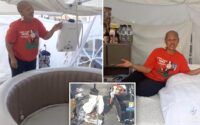Nuclear reactor to power ‘eventual human colony’ on Moon one step closer to reality after latest NASA move
NASA is moving forward with plans to install a nuclear reactor on the Moon to support “an eventual human colony” and power lunar bases for its Artemis program.
The space agency is extending three $5 million contracts granted in 2022 to develop a small, electricity-generating nuclear fission reactor, officials said in a Jan. 31 press release.
NASA plans to solicit the design for a final reactor in 2025, which it hopes would be in place for a one-year demonstration in the early 2030s, followed by nine operational years when it could provide electricity for a “sustained human presence” on the Moon.
If that goes well, the reactor could be updated for potential use on Mars, where NASA hopes to send astronauts in the next decade, scientists say.
The technology is needed because of the limitations of solar energy on the celestial body, which has nights equivalent to 14.5 days on Earth.
“The lunar night is challenging from a technical perspective, so having a source of power such as this nuclear reactor, which operates independent of the Sun, is an enabling option for long-term exploration and science efforts on the Moon,” said Trudy Kortes, program director of Technology Demonstration Missions within NASA’s Space Technology Mission Directorate at NASA Headquarters in Washington.


Under the continuing first phase of the Fission Surface Power Project, Lockheed Martin, Westinghouse and IX are tasked with creating initial designs that include a reactor, and its power conversion, heat rejection, and power management and distribution systems.
“A demonstration of a nuclear power source on the Moon is required to show that it is a safe, clean, reliable option,” Kortes said.
Reactors would have to be under six metric tons and produce 40 kilowatts of power — enough to power about 30 households back on Earth.
“We’re getting a lot of information from the three partners,” said Lindsay Kaldon, Fission Surface Power project manager at NASA’s Glenn Research Center in Cleveland.
“We’ll have to take some time to process it all and see what makes sense going into Phase 2 and levy the best out of Phase 1 to set requirements to design a lower-risk system moving forward.”
NASA’s Artemis missions aim, over the next few years, to establish the first long-term human presence on the Moon to gather information that will be used to send human beings to Mars.
Astronauts have not been on the Moon since 1972, three years after Apollo 11’s historic first mission.


